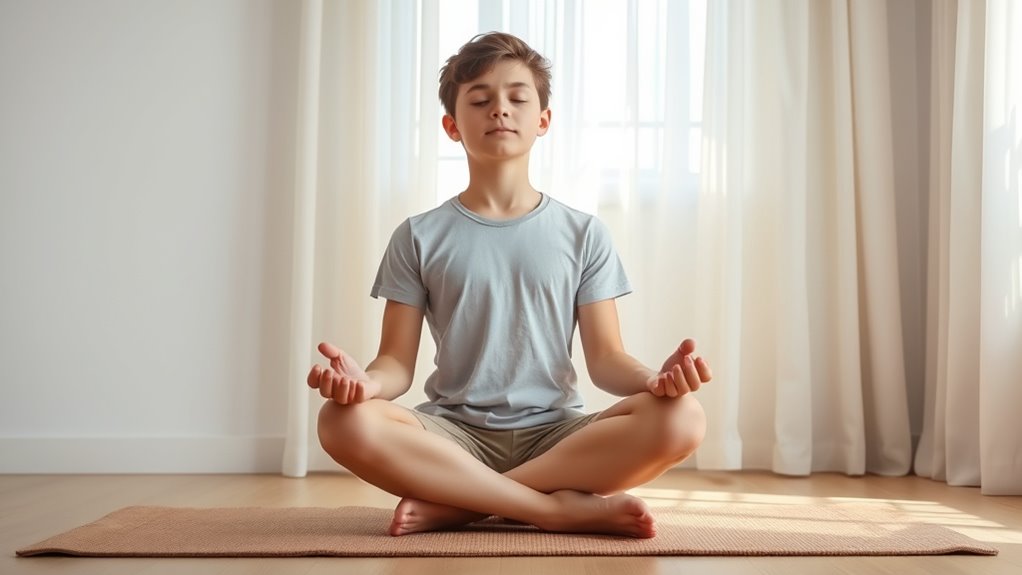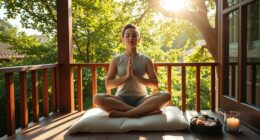To start with simple breathing techniques, focus on mindful breathing or diaphragmatic breathing. Sit comfortably and take slow, deep breaths, feeling your belly rise and fall with each inhale and exhale. These practices help reduce stress, calm your mind, and improve focus quickly. They’re portable and easy to do anywhere, making them great tools for everyday relaxation. Keep practicing regularly, and you’ll discover even more benefits that can enhance your well-being over time.
Key Takeaways
- Practice mindfulness meditation by focusing on breath awareness to quiet racing thoughts and stay present.
- Use diaphragmatic breathing by placing one hand on the belly and inhaling deeply to engage the diaphragm.
- Perform slow, controlled inhalations and exhalations through the nose or mouth to promote relaxation.
- Incorporate breathing exercises into daily routines, such as during breaks or before bed, for consistent stress relief.
- Keep techniques simple and portable, enabling practice anywhere—at your desk, in bed, or while waiting.

Have you ever wondered how simple breathing exercises can improve your overall well-being? It might surprise you to learn that just a few minutes of mindful breathing each day can make a significant difference in your mental and physical health. One effective way to start is by exploring mindfulness meditation, which encourages you to focus your attention on your breath. This practice helps quiet racing thoughts and anchors you in the present moment, reducing stress and promoting a sense of calm. When practicing mindfulness meditation, you simply sit comfortably, close your eyes if you like, and observe your breath without trying to change it. Pay attention to the sensation of air entering and leaving your nostrils or the rise and fall of your chest or abdomen. This focused awareness trains your mind to stay present, making it easier to handle daily stressors and emotional ups and downs. Incorporating expert voice actors into guided meditations can enhance your experience and deepen your relaxation.
Another beginner-friendly breathing technique is diaphragmatic breathing, often called belly breathing. This method emphasizes deep, full breaths that engage your diaphragm, a muscle located beneath your lungs. To do this, place one hand on your chest and the other on your belly. Inhale slowly through your nose, allowing your belly to rise as it fills with air, rather than just your chest. You want your belly to expand, indicating that you’re taking in a deep breath that maximizes oxygen intake. Then, exhale slowly through your mouth or nose, feeling your belly fall as you release the air. Diaphragmatic breathing helps slow your heart rate, lowers blood pressure, and relaxes your nervous system. It’s especially helpful during moments of anxiety or tension, providing an immediate sense of control and calm.
The beauty of these techniques is that they’re simple and portable—you can do them anywhere, anytime. Whether you’re sitting at your desk, lying in bed, or waiting in line, taking a few mindful breaths can reset your mood and focus. Consistency is key; even a few minutes daily can build your resilience to stress over time. As you become more familiar with mindfulness meditation and diaphragmatic breathing, you’ll notice your body responds with relaxation, and your mind clears. These practices serve as foundational tools for beginners, offering quick relief from everyday pressures and fostering a greater sense of awareness and tranquility. With patience and practice, you’ll find breathing exercises not just helpful, but essential for maintaining your overall well-being.
Frequently Asked Questions
Can Breathing Techniques Replace Medical Treatment for Anxiety?
Breathing techniques can’t replace medical treatment for anxiety, but they can complement it. As you practice different breathing patterns, you may notice meditation benefits like reduced stress and improved focus. These techniques help manage symptoms, making you feel calmer. However, if your anxiety is severe, it is crucial to seek professional help. Combining breathing exercises with therapy or medication often offers the best results for overall mental health.
How Often Should Beginners Practice Breathing Exercises Daily?
Start with practicing breathing exercises twice a day, ideally in the morning and evening. For example, Sarah practiced diaphragmatic breathing daily, and after a week, she noticed reduced anxiety. To see benefits, practice consistency and find the most effective timing that fits your schedule. Most beginners find that 10-minute sessions twice daily help establish a habit and improve overall relaxation. Stick with it for lasting results.
Are There Any Risks or Contraindications for Specific Breathing Methods?
You should be aware of medical contraindications and prioritize breathing safety when trying specific methods. Some techniques, like breath-holding or rapid breathing, might not be suitable if you have respiratory issues, heart conditions, or anxiety disorders. Always listen to your body, start slowly, and consult a healthcare professional if you have concerns. Ensuring safe practice helps prevent dizziness, hyperventilation, or other adverse effects.
Can Breathing Exercises Help Improve Sleep Quality?
Breathing exercises can definitely help improve your sleep quality by promoting relaxation and reducing stress. These relaxation methods slow your heart rate and calm your mind, making it easier to fall asleep and stay asleep longer. Incorporating simple breathing techniques into your bedtime routine enhances sleep enhancement. Consistent practice helps your body associate these exercises with rest, leading to better sleep patterns over time.
What Equipment or Space Is Needed to Start Practicing?
You only need minimal equipment to start practicing breathing techniques—just find a quiet space where you’re comfortable and undisturbed. No special gear is necessary; a simple chair or cushion works well. Focus on creating a calming environment, free from distractions, so you can concentrate on your breath. With just these basics, you can easily incorporate breathing exercises into your daily routine, helping you relax and improve your overall well-being.
Conclusion
By practicing these simple breathing techniques, you open your mind, calm your body, and clear your thoughts. Each breath becomes a wave that washes away stress, a breeze that refreshes your spirit, and a rhythm that grounds you in the present. With consistency, your breathing becomes a steady anchor, a gentle guide through life’s chaos. Embrace these practices, and let your breath lead you to peace, clarity, and a renewed sense of calm in every moment.








